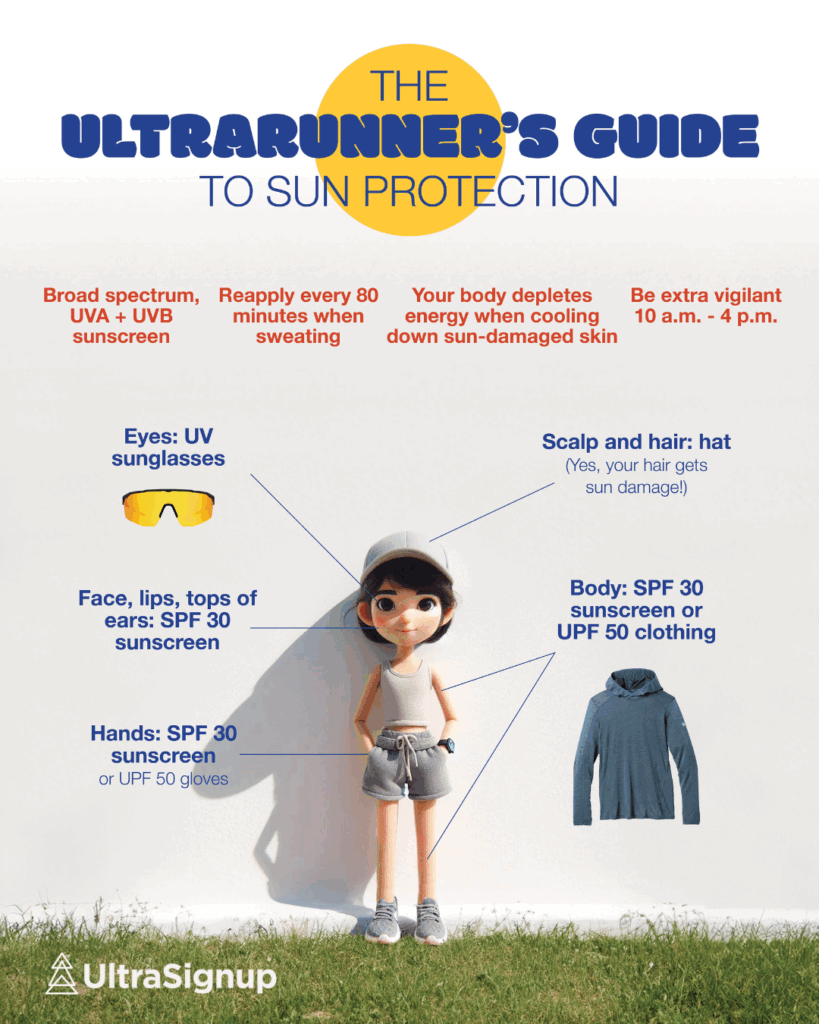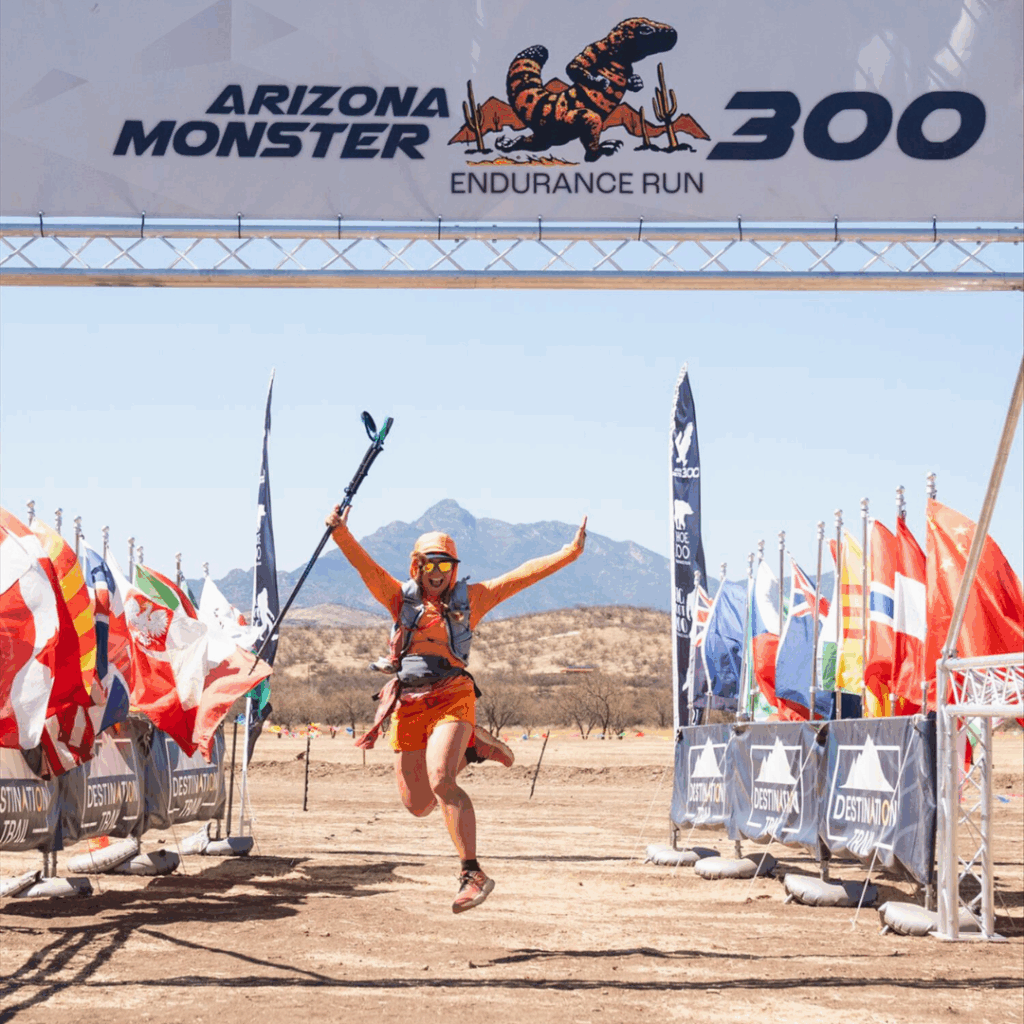
UV rays damage exposed, unprotected skin. Damage not only increases risk for skin cancer and ages the skin faster, but your body starts working harder to heal it within a couple hours of getting damage. Additionally, if you’re running during the day for many hours with no sun protection, your skin will be constantly working to cool down the skin’s surface, taking energy from the body.
“The sun can greatly impact an athlete during an all-day or multi-day event,” says Brooke Weinberger, PA-C, MPAS at the Boulder Valley Center for Dermatology. “[When exposed to the sun], skin works to cool the body by releasing sweat onto the surface through evaporation. If sweating is prolonged, the tissues can lose blood flow and performance will be reduced.”
When you’re running an ultra, you want your body to conserve as much energy as possible. So, why risk it, potentially decreasing your performance, aging your skin, and increasing risk for cancer?
Weinberger and her colleague, Thomas Casey Gallagher, MD, both avid outdoor recreators, recommend building in sun protection as part of your daily skin care and running routines. Once you have the habit of reapplying often on your long runs or throwing on your running-friendly UPF clothing, the more protected and healthier your skin will be for years to come.
When I started running ultras four years ago, I made it a point to put sunscreen on my whole body for every single run. I wore a hat on every run, too. And yet, last month, I was diagnosed with an early- stage skin cancer on my lip, the one place I didn’t put sunscreen those four years! That’s over 9,000 miles of running without an SPF lip balm. If this isn’t a perfect example of why ultrarunners need to protect all parts of their bodies, I don’t know what is.
I tried not to shame myself too much, and I am lucky enough to have caught it very early at my dermatology check-up. The lab pathologist who analyzed the biopsy said it had just barely crossed over from pre-cancerous to cancerous. My incredible care team provided me with multiple options for treatment, but ultimately, I chose the Mohs procedure to quickly remove all the skin cancer papules. It’s now my mission to pay my newfound knowledge forward to my endurance sport community so you don’t make similar mistakes. We have too much fun out there in the sun- desert, forest, beach, mountains, and we deserve to have skin that will stand the test of time the way our love for running does.
For Skin Cancer Awareness Month, I asked Gallagher and Weinberger to weigh in on specific measures ultrarunners and endurance athletes should take to protect their skin from the sun and reduce risk of fatigue.

T.C.G.: I always recommend SPF 30 or higher (lips and skin) for folks who will be exercising outdoors. To help the sunscreen last when you know you’ll be sweating, look for a water-resistant brand, and that should last about 80 minutes. After that, if you have been sweating, you’ll need to reapply the sunscreen.
B.W.: Look for “broad spectrum,” which means it blocks UVA and UVB rays. Both mineral or chemical sunscreens are appropriate and safe. Use a water break as a time to reapply your sunscreen. Be sure to check your sunscreen bottle as they expire.
T.C.G.: UPF clothing is terrific- it’s comfortable, lightweight and does a great job protecting your skin. I always recommend UPF 50 or higher, which will protect your covered skin all day. Of course, if you have skin that’s not covered, like your hands, legs, neck or face, you’ll need to put sunscreen on those areas.
B.W.: UPF clothing is highly effective—more effective than sunscreen because most people are not using sunscreen perfectly.
T.C.G.: You might feel cooler at a higher altitude and forget to reapply sunscreen after sweating or getting in the water. Try to remember that a cooler body temperature does not mean you’re not getting harmful sun exposure or that you won’t get a sunburn. In fact, you’ll burn faster at high altitude on a sunny summer day, because there’s less atmosphere to filter out the harmful UV rays!
B.W.: For higher elevations, you are closer to the sun, and you have to be even more cautious with your sun protection! I would recommend reapplying your sunscreen SPF 30 or above every hour if you are sweating continuously.
T.C.G.: Folks with darker skin are at lower risk for sun damage and skin cancer, but cancer can strike all skin types, so it’s best for everyone to protect against the sun’s rays. And there is no such thing as a safe tan. A “base tan” cannot occur without damaging the skin, and that damage increases the risk of skin cancer.
B.W.: I do not recommend relying on a tan or a darker skin tone to protect from skin cancer. If you want a nice, bronzed look, use a sunless tanning product. There are many excellent ones on the market, or a spray tan.
T.C.G.: Going outdoors before 10 a.m. and after 4 p.m. are the safest times for your skin. A general rule of thumb is to wear sunscreen whenever you go out into the sun, regardless of the time, but if you want to get extra nerdy, you can check the UV index before you venture out. The UV index which is a measure of the sunlight’s strength. If the index is 3 or higher, you should have on at least SPF 30 when you go outdoors.
B.W.: The chemical sunscreens that are on the market these days have been vetted by the Food and Drug Administration to be safe. Chemical sunscreens and mineral sunscreens have roughly equal efficacy. However, if you prefer to avoid chemical sunscreens, thankfully there are plenty of mineral sunscreens (also known as physical sunscreens) that physically block the sun’s rays. These contain zinc oxide or titanium dioxide, which leave a white cast. There is an option of clear zinc sunscreen that doesn’t leave this cast.
B.W.: I don’t recommend intentionally exposing the skin to the sun in order to get Vitamin D. If you’ve been told you have low Vitamin D, I recommend using a supplement instead of the sun to replenish this. Please talk with your primary care provider if you think you may have low Vitamin D.
What we’ve learned is that people who wear sunscreen tend to spend more time outside, and, even with best intentions, most people are not using sunscreen perfectly. Therefore, these individuals usually end up getting sufficient Vitamin D from the sun.
T.C.G.: Try to time your workouts during the cooler hours of the day: You’ll perform better, and you’ll keep your skin safer. Always apply sunscreen at least 15 minutes before you go out into the sun. That gives the sunscreen time to absorb into your skin, so that you’re protected as soon as you get out to start your exercise routine.
B.W.: You can enjoy being out in the sun and enjoy a lifetime of healthy skin by following these strict sun protection guidelines: SPF 30 or above applied about 10 minutes before sun exposure, then reapply every two hours, or every hour to hour and a half if you are sweating continuously. Use your water breaks as a sunscreen break as well! Always carry sunscreen in your pack while out on a long run so that it’s readily available to reapply.

At your annual visit to the dermatologist, you can always ask about specific methods of sun protection for your lifestyle. What we’ve learned from our experts is: UPF clothing, mineral, chemical sunscreens, and exercising early in the morning or at night are great methods to keep your skin safe. If you’re always protected, you can run your long runs and races with peace of mind knowing your body will be working less hard to reduce the damage from the sun.

Thank you for these great tips. I will start being consistent with my lip sunblock going forward.